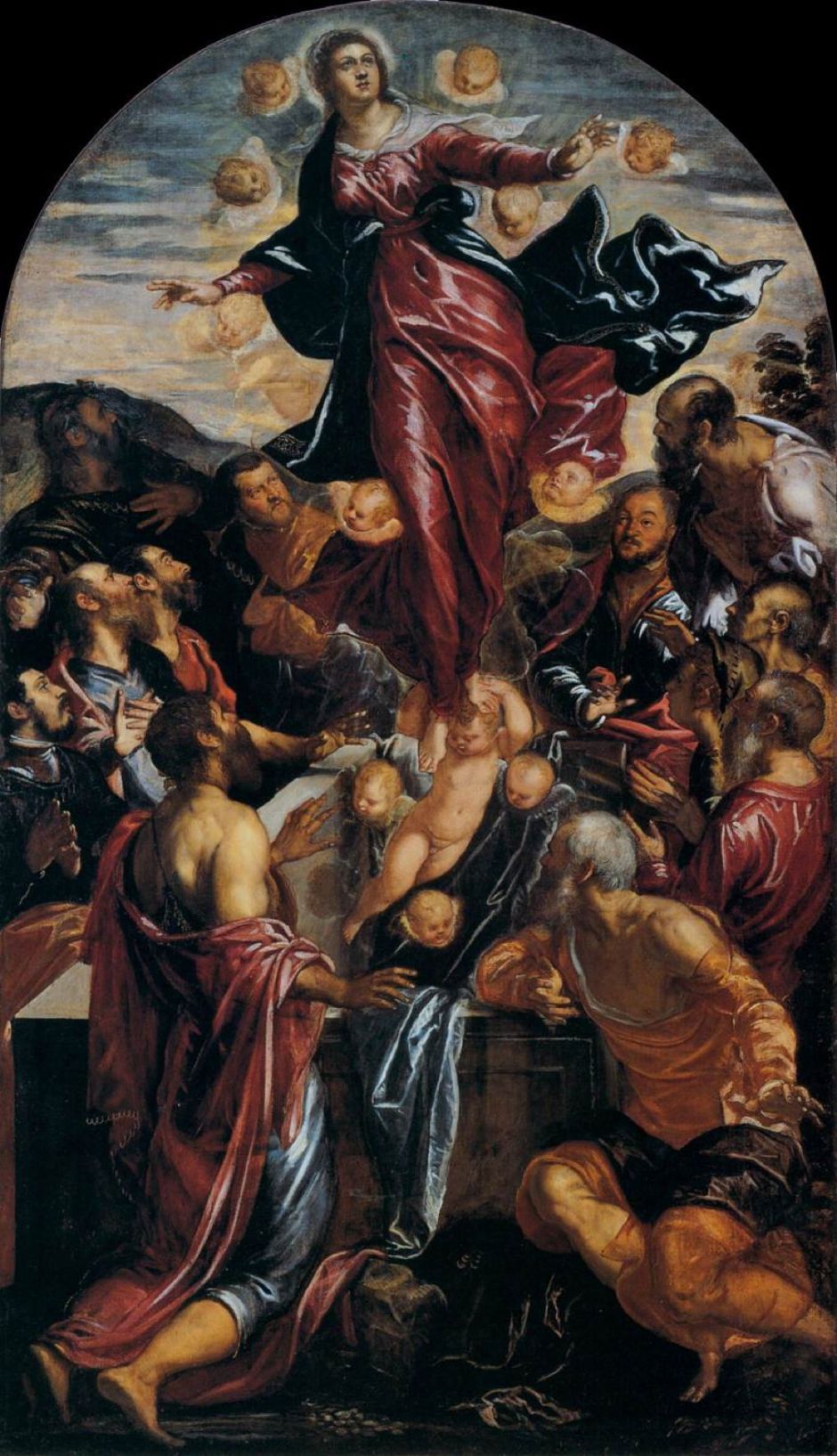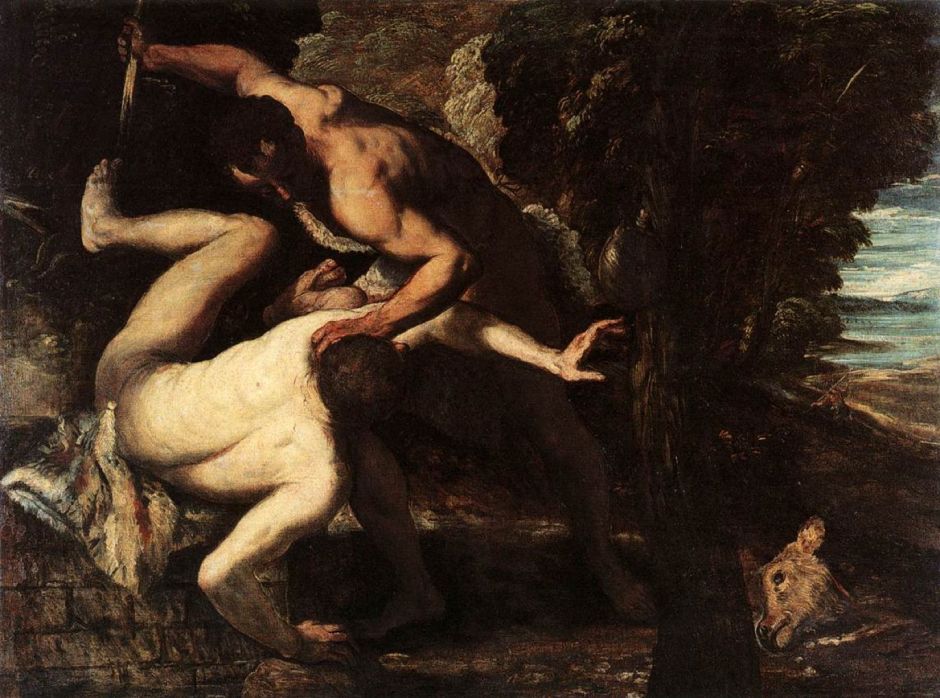In 1548, with his Miracle of the Slave (E&I 46) (discussed in my previous article), Tintoretto had made a success of his first really large-scale commission, bringing him renown throughout Venice.
Before I move on to look at his subsequent religious and narrative paintings, there are three slightly earlier works I’d like to look at briefly.

Allegory of the Dreams of Men (E&I 38) from about 1546 is little-known, but belonging to the Detroit Institute of Arts is accessible to many in North America. It was apparently commissioned for the ceiling of a bedroom in the Casa Barbo, in Venice, where it must have looked really splendid.
It incorporates a rich variety of symbols from astrology, arranged in a near-symmetrical fashion around its central figure. Against a background of signs of the Zodiac, there’s a decorated crescent moon, gold coins pouring from the clouds, and a minor pantheon of foreshortened figures. At the foot is Father Time with his sandglass, and each of the other figures appears to merit careful iconographic study.
Tintoretto also painted many portraits, which I can only dip into occasionally, or this series would last until the end of the year. I have selected two which I find of particular interest at this stage in his career.

This Portrait of Jacopo Sansovino was painted before 1546, is a good example of his portraiture work, and bears a significant inscription. Sansovino (1486-1570) was a major sculptor and architect of the day, best-known for his buildings around the Piazza San Marco, which are so distinctive of Venice.
This shows him as a young man; Tintoretto also painted him when he was visibly much older. The artist signs himself in the inscription ‘Jacobus Tintorettus his greatest friend’.

Tintoretto also painted his Self-Portrait in about 1547, looking young, wide-eyed, and intense.

Within a year of completing the huge Miracle of the Slave, Tintoretto painted the large Christ Washing the Disciples’ Feet (E&I 47) for the Scuola di San Marcuola, now in the Prado. This painting has been analysed extensively, and its carefully-projected buildings and table reconstructed by Ana González Mozo.
The disciples are gathered in a palatial room, around a large refectory table which looks appropriate for the Last Supper, an event which appears to be depicted in a painting hanging on the wall. In the right foreground, Jesus Christ is washing the feet of those disciples one by one, with them standing in turn in a shallow wooden tub. Elsewhere, disciples are seen pulling one another’s boots off, and a hound sits alert in the centre foreground.

Venice was particularly prone to outbreaks of plague, and developed procedures and establishments for coping with cases. In his large canvas showing Saint Roch Heals Plague Victims (E&I 50) from 1549, Tintoretto shows those suffering from plague brought to a small chapel, where the saint is healing them. The dark room is already collecting a disarray of bodies, some seemingly close to death. Without the miraculous work of the saint, this would quickly have become the waiting room for hell. This work was painted for Saint Roch’s church, the Chiesa di San Rocco, in Venice.

Later in his career, stock motifs such as the Assumption of the Virgin (E&I 53) would have been left largely to his workshop, but this example from the early 1550s, for San Stin in Venice, is thought to have been executed by Tintoretto himself. Although it looks to have been painted at speed (as he was reputed), the Virgin Mary’s body language and expression have a presence about them, and many of the figures appear intriguing.
Between 1550 and 1553, Tintoretto painted four works for the Scuola della Trinità showing scenes from the early chapters of the book of Genesis, of which I here show the three which are now in the Gallerie dell’Accademia in Venice. The fourth, showing Adam and Eve before God, is now in the Uffizi in Florence.

In Creation of the Animals (E&I 55), the first of the cycle, God flies along as he is creating pairs of different species of bird, fish, and animal, from cormorants to rabbits. His use of colour for the garments of God and near-monochrome for the creatures, coupled with strong design, result in an image which is almost a forerunner of the more graphic works of William Blake.

The Temptation of Adam and Eve (E&I 57) is also a strong design, but one in which the viewer almost joins Adam in seeing Eve’s nakedness, and the tempting apple being proferred in her hand. This is a theme which he was to return to in Susannah and the Elders, very shortly (and covered in the next article).

The last of the four, showing Cain Killing Abel (E&I 58), has the two brothers embroiled in a fight, with Cain’s right hand raised, about to bring a knife down into Abel’s body.
At about this time (1552), Tintoretto completed three religious paintings for the Palazzo dei Camerlenghi, which were to lead on to an early masterpiece: Saint George and the Dragon (c 1553), which I examine in the next article.
References
Robert Echols and Frederick Ilchman (2009) Toward a new Tintoretto Catalogue, with a Checklist of revised Attributions and a new Chronology, in Falomir op cit.
Miguel Falomir (ed) (2009) Jacopo Tintoretto, Proceedings of the International Symposium, Museo Nacional del Prado. ISBN 978 84 8480 171 9.
Roland Krischel (ed) (2017) Tintoretto, A Star was Born, Hirmer (in German). ISBN 978 3 777 42942 7.
Tom Nichols (2015) Tintoretto, Tradition and Identity, 2nd edition, Reaktion Books. ISBN 978 1 78023 450 2.

